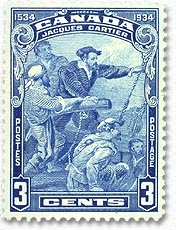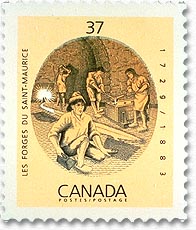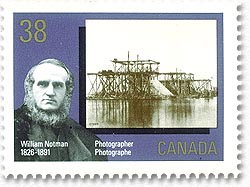

Workers are not totally excluded from depictions of various stages in Canadian history, but again they do not rate high on the scale of intentionality. As early as 1534, for instance, we can discern that the explorer Jacques Cartier was accompanied by other seafarers, here shown on a 1934 stamp (#208) that contains an image both of the hierarchy and the collective effort of seafaring labour. The participants in Henry Hudson's fateful expedition of 1610 are depicted on a somewhat gloomy 1986 stamp (#1107); there is no specific indication that his discontented sailors were the organizers of what was arguably the first labour revolt in Canadian history.
Canada Scott 208
Stamp reproduced courtesy of Canada Post Corporation
|
 |
An early scene in the growth of industry in New France is represented in a 1988 stamp (#1216) that focuses on the iron workers and apprentices who worked at the Forges du Saint Maurice. By contrast, the businessman John Molson dominates the foreground of a 1986 stamp (#1117) and the presence of workers is firmly subordinated to the image of the entrepreneur. The cowboys of the western ranching industry are in action on a stamp for the city of Calgary in 1975 (#667). The immigrant experience is depicted several times, including the arrival of the Hector (#619), the Loyalists (#209), the Mennonites (#643), and the Ukrainians (#1326) - interestingly, all of these are shown in family groupings.
 |
Canada Scott 1216
Stamp reproduced courtesy of Canada Post Corporation
|
The transportation theme looms large in the narrative of Canadian history contained in postage stamps, and again the presence of workers is indispensable if rarely central to the intentionality of the stamps. The voyageurs who powered the great fur trading canoes into the northwest can certainly be seen in action, first of all in Frances Ann Hopkins' painting (#1227), issued in honour of the artist, and secondly in the fantasy of the chasse-galerie or bewitched canoe (#1334), which flew by night and forms part of a series on Canadian folklore. The construction of the canals in the 19th century may be deduced from an examination of a 1974 stamp paying tribute to William Merritt (#655); although the navvies themselves are not shown, we can see in the background workers engaged in a variety of labouring tasks on the canal. The successors to the canal labourers were the construction workers who built the railways, and their absence is perhaps the most surprising omission in the entire canon of Canadian postage stamps.21 Again, their presence may be deduced from the appearance of workers in a photograph of the construction of the Victoria Bridge, the first railway link across the St. Lawrence at Montréal; this stamp was issued in tribute to the photographer William Notman (#1237). The workers who built the 20th-century highways are represented more directly in a 1992 stamp commemorating the
completion of the Alaska Highway (#1413). A more ambiguous comment on changes in transportation technology in the north at midcentury appeared in 1955 in the image of an Inuk at rest in his kayak while an airplane wings by overhead (#351).
Canada Scott 1237
Stamp reproduced courtesy of Canada Post Corporation
|
 |
|



